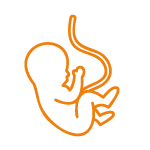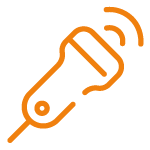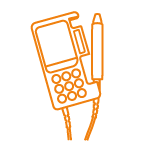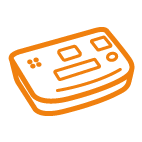Frequently asked questions
Patients and healthcare professionals have the same or similar questions on the subject of drainage of pleural effusion and ascites. That is why we are making this section available to you and provide all interested parties with answers to the most frequently asked questions.
Frequently asked questions
Patients and healthcare professionals have the same or similar questions on the subject of drainage of pleural effusion and ascites. That is why we are making this section available to you and provide all interested parties with answers to the most frequently asked questions.
If the catheter has been completely and correctly covered with the self-adhesive film dressing, you may shower. If the gauze compresses get wet while showering, remove the dressing, clean and dry the area and apply a new dressing. The catheter must not be immersed in water in a bath or swimming pool.
Our recommendation: Take a shower before you drain and change the dressing. If the dressing becomes soaked while showering, it will be replaced promptly.
The skin suture (the suture furthest from the catheter exit site) can be removed after 10 days and the retaining suture (the suture directly at the catheter exit) after 30 days. The sutures are usually removed on an outpatient basis in the hospital or clinic where the catheter was implanted. However, the stitches can also be removed by the family doctor or home nursing service.
Yes, you will receive personal instructions on draining the effusion from our product specialist after leaving the hospital or clinic. He will explain to you step-by-step and show you what you need to bear in mind. Finally, he will also give you our patient folder, in which all the information is available for you to read again.
No, the drainage set is intended for single use and must not be used more than once for reasons of hygiene and the risk of infection.
The fluid should be drained with a drainage set every one to two days or as prescribed by your doctor. Ask your doctor if you want to drain fluid more frequently or less frequently. However, drain a maximum of 1000 ml of fluid per day from the chest cavity or a maximum of 2000 ml of fluid per day from the abdominal cavity.
There may be two reasons for this:
- If the amount of drainage was normal and this time there is no effusion at all, the catheter or the safety valve may be blocked. Try to clear the blockage by squeezing and pushing out the catheter. If the effusion cannot be drained, change the reservoir. The blockage may be directly in the insertion pin. If the drainage still does not work, contact your doctor.
- If the amount of drainage continues to decrease and you have no complaints or weight gain, it is possible that no more fluid is accumulating. Discuss the next steps with your doctor.
If you still have difficulty breathing after successful drainage of fluid from the chest or abdominal cavity, contact your doctor.
If the color or composition of the effusion changes, this is not an acutely threatening situation. Your doctor will be able to explain the cause of this based on the course of your illness. If the effusion becomes cloudy or there is even fresh blood in the effusion, you should contact your doctor.
If an effusion no longer forms or your treating physicians decide to remove the catheter for other reasons, the catheter can also be removed under local anesthesia.
The indwelling catheter does not need to be changed or replaced as long as no signs of infection such as redness, swelling or overheating are associated with the catheter and the catheter is functioning properly.
Yes, improper handling can damage the catheter. Please read the instructions for use carefully. Only use alcohol-based disinfectants for skin and hand disinfection.
The material prescribed by the doctor will be sent to your home free of charge by ewimed Switzerland AG after you leave hospital. If you need additional drainage sets, you can order them directly from ewimed Switzerland AG on this website, by phone or e-mail. The prescription drainage sets are not available from medical supply stores or pharmacies, so we can advise you on their correct use at any time.
Further information on this can be found in the ewimed service and care concept
You can take the catheter on vacation and even abroad. When preparing for your trip, you must ensure that you order sufficient drainage sets from fenik in advance. Please also observe the usual disposal regulations of the respective country. Discuss the upcoming trip with your doctor.
Discuss this question with your doctor before you travel. They will be able to give you the best advice depending on your underlying illness.
If you are allowed and able to travel by air, be sure to order sufficient drainage sets and a special bag to take with you in your hand luggage. See also Can I go on vacation with it? Even abroad?
If you have any complaints regarding your catheter or effusion during your trip, consult a local doctor immediately.
No, the drainage sets are not available in pharmacies or medical supply stores, but exclusively from ewimed Switzerland AG.
Ordering options
- Please use the order form on our website.
- Send us an e-mail to info.ch@ewimed.com
- Call us on the main telephone number +41 52 577 02 55 or service telephone number +41 31 511 87 20
Drainage sets are fully reimbursed by the health insurance company after receipt of a doctor’s prescription!




